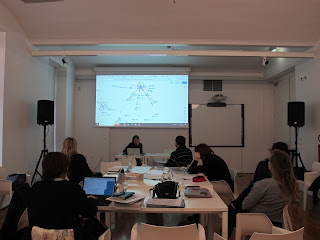Study Workshop at basis wien, 3-4 April 2023
Early in April 2023 the partners met for their first workshop in Vienna. After a long preparatory phase, all participants were eager to get together for this two-day event at basis wien.
The project Art Archives Study (ARTAS) aims to examine the changes brought on by the enlargement of the EU in 2004, with a special focus on Austria, the Czech Republic and Slovenia, where the three participating archives are based and which are the subject of their respective archives of documentation.
The approach taken in this project is a two-fold one combining statistical data analysis with classical research methods. Based on their collection of structured meta data, each partner prepared a list of queries to serve as a starting point for deeper analysis. These queries, which were determined together and implemented at each of the archives in the preparatory phase of the project, were selected to create a common basis and to contain compatible findings for all three partners, for the comparison of results and evaluation during the workshop.
In this first workshop, the partners began with an initial evaluation of the data. While the archives have been collecting and working with metadata for a long time, looking at their data in terms of statistical data analysis and not to find specific results is rather a new approach/strategy. In the context of the ARTAS project, the discussion revolved around questions like: Is it possible to trace a person's movement through their data (e.g., their participation in exhibitions abroad)? How does the data collected by the three archives overlap (or not?) and correlate? How can we interpret these overlaps, correspondences or matches and gaps?



For this first workshop, the partners concentrated mainly on connections between people and places as well as between people and exhibitions. People are connected to their places (city, region, country) of birth, residence and work — or death in each of the databases. Exhibitions can be attributed to an identifiable geographic location by means of the address of the institution/venue concerned.
All three archives' collections have a focus on the country where they are based. They document exhibitions held in the country concerned — in which many people from other countries also participated. So, each of the databases contains the most data on people connected to the country it is based in, along with data on a significant number of people with connections to other countries. The first surprise when analysing the data was that in all three databases there were a substantial number of people for whom no connection to any specific location was known. This needs to be taken into consideration when analysing the data.
In terms of connections between the participating countries, results from RazUme (the database of Moderna galerija) in Ljubljana, generally showed a stronger connection to Austria than to the Czech Republic, both in exhibitions involving people in Slovenia with connections to Austria and in exhibitions with people with connections to Slovenia in Austria.
The findings from the abART database (the
Archive of Fine Arts) in Prague also show markedly higher numbers of documented
events involving people with connections to Austria than with connections to
Slovenia.
Looking at the numbers from the basis wien database, there is no such significant discrepancy, while numbers are slightly higher for exhibitions with people connected to the Czech Republic than to Slovenia. This is also true of documents from Czech Republic and Slovenia respectively.
The findings based on the queries has already provided useful ground for deeper research, defining content for a subsequent workshop (to be held in August 2023). Possibilities for the visualization of the data were discussed, and suggestions were presented.
For the second part of the workshop, basis wien prepared documents and publications from their in-house archives and library in connection with specific events dating from around 2004 and of relevance to the enlargement of the EU in that year.
The material was put on display for all workshop participants to peruse, so they could read the texts and reflect on their physical expression, the language used and the formal approaches taken.
It seems noteworthy that in Austria there is a strong connection between commercial interests and cultural engagement in "Central Eastern Europe" around the year 2004, and in a context of the EU enlargement.
This is reflected strikingly in the use of the term applied to the geographic area concerned: Central Eastern Europe (CEE). In 2005, a new commercial art fair was launched in Vienna that marked the first attempt to operate on a large international scale. With CEE as its focus, a separate section of exhibition booths was devoted to representing galleries from the new EU states. This section of the art fair was sponsored by Erste Bank.
Due to the frequent sponsoring
activities by banks, insurance companies and firms (compiling corporate-owned collections
and creating their own programmes) in the countries concerned, the participants
gave special attention to the relevant holdings and to the development of such
programmes.
In 2004, not only was the Kontakt Collection (ERSTE Bank) established, the BAWAG Foundation and the Generali Foundation also organized exhibitions that addressed the topic of "East" and "West". The curatorial concepts that explicitly deal with the terminology and structure of Europe suggest that the EU enlargement was regarded as a change in previously accepted structural, commercial and historically evolved connections with and concepts of Eastern and Western Europe.
Exhibitions like "Eintritt frei" ("Eintritt Frei. Kunst aus Bratislava, Budapest, Ljubljana, Prag und Wien", BAWAG Foundation, 2004) and "COLLECTED VIEWS FROM EAST OR WEST" (Generali Foundation, 2004) had in common that they were organized by institutions with commercial interests in the new EU countries. The Essl Art Award CEE, founded in 2005, can also be seen in a context of the commercial activities of collectors Agnes and Karlheinz Essl, the owners of Baumax, a chain of DIY markets that profited significantly from their expansion into Eastern Europe at the time.
Different points of interest emerged on the basis of the available material which are to be researched in greater depth by the archives concerned in due course. In particular, the correlation between banks and their activities in the field of art during the years around the eastward expansion of the EU is to be examined more closely, along with the branding of the "East" that developed in connection with it, as well as the elaborately curated, multi-layered projects of this period that were dedicated specifically to the topic of attributions of East and West.
Research in the basis wien library and archive.
As an optional evening programme, the participants were invited to attend a film screening and talk with the artist and theorist Marina Gržinić, who has been teaching at the Academy of Fine Arts in Vienna for several years and lives in Slovenia, about the film "RELATIONS/25 Years Of The Lesbian Group ŠKUC-LL" by Marina Gržinić, Aina Šmid and Zvonka T Simčič.
"This documentary video film is about the 25 anniversary of the lesbian group ŠKUC-LL (1987-2012) and about the lesbian movement in former Yugoslavia. It is a project that visualizes and defines the context for the movement and of the LGBTQ community within and with relation to politics, economics, culture, the arts and legal institutional structures; this contextualization operates on two levels: first, from the decaying socialism to neoliberal capitalism, and then in the time of the 1990s it depicts the transition to a present, bloody neoliberal global capitalism. The film includes analysis of the movement in the EU after 2004, when Slovenia became a member of EU, and includes discussions and analysis of the "climate" that followed discussion and the rejection of a new family code in Slovenia in 2012. The family code was rejected in a referendum held in March 2012, when the majority decided negatively on basic human rights for same-sex unions and their children. A special place is given in the film to the Pride Parades in the ex-Yugoslavian territory."
(See http://grzinic-smid.si/?p=276)
On the second day, the workshop participants left the premises of basis wien for several outside events. After viewing the exhibition Lenka at the Czech Cultural Centre, the participants visited the exhibition Otis Laubert at Knoll Galerie Wien. Here they met Hans Knoll, with whom they conducted a long interview where he kindly shared his experiences of opening an art gallery in Hungary in 1989 and his extensive travels in other Eastern European countries before and after the fall of the iron curtain.
For the first time, all three archives conducted an interview together. The questions revealed different approaches to the art market, fairs, individual artists, their careers, cooperations with museums, the historical dimensions of the private collection culture in their respective geographic locations and the interconnectedness of the individual archivists. A transcription of this interview is to be made available in all three archives.
Interview with Hans Knoll in his gallery in the exhibition Otis Laubert.
Other activities within the framework of the two-day meeting included a visit to the exhibition on the road again at the Vienna Künstlerhaus, where curators Simon Mraz and Clemens Helbock gave participants a guided tour of the exhibition and explained its background — on display were projects that had been selected from a call in 2021, when the Austrian foreign ministry had invited artists to submit projects to the Austrian cultural forums in 23 cities worldwide as a means of support after the corona lockdowns. It was the first collective call for all Austrian cultural forums. A jury chose the exhibited projects from a total of 478 applications. Most of these were realised in the intended locations in 2022, and were subsequently being shown as part of the collective exhibition at Künstlerhaus.
In conclusion, the first workshop proved to be very productive, the approach and methodology chosen have already yielded some promising results and opened up avenues for further research. The documentation in the basis wien archives confirms that the EU enlargement in the year 2004 has had a significant impact on the Austrian cultural landscape.
Group photo (from left to right): Veronika Rubášová, Barbora Špičáková, Teja Merhar, Andrea
Neidhöfer, Ana Obid, Helene Baur, Jan Kuntoš
Disclaimer: „Funded by the European Union. Views and opinions expressed are however those of the author(s) only and do not necessarily reflect those of the European Union. Neither the European Union nor the granting authority can be held responsible for them.“












Comments
Post a Comment